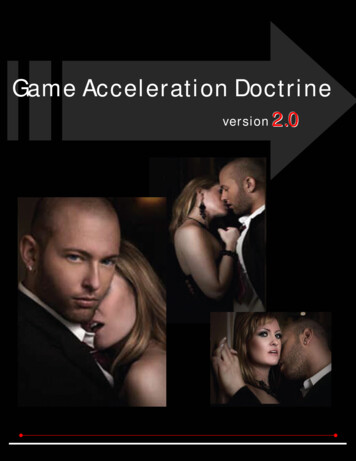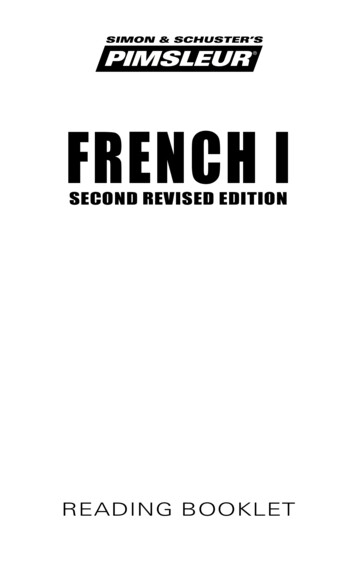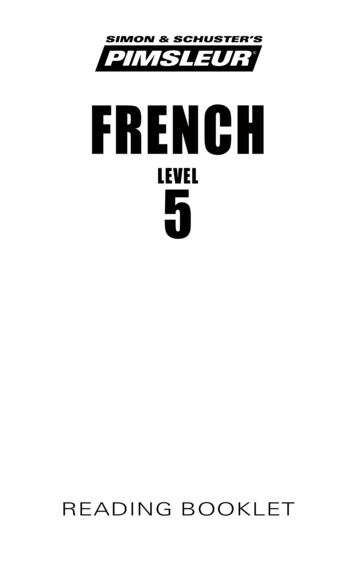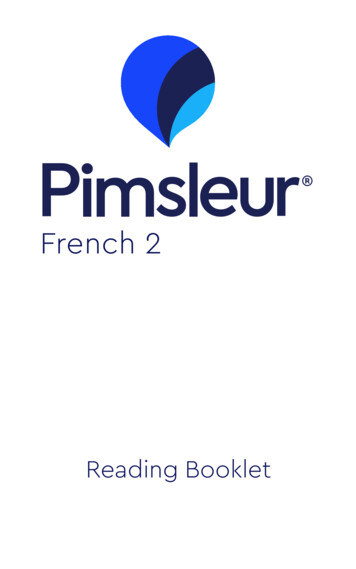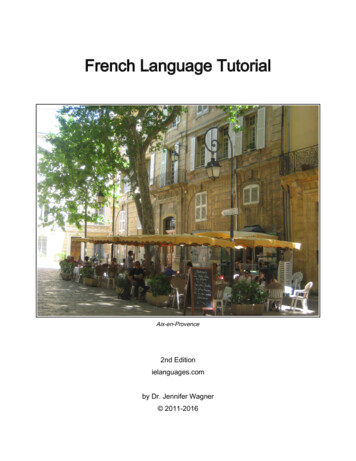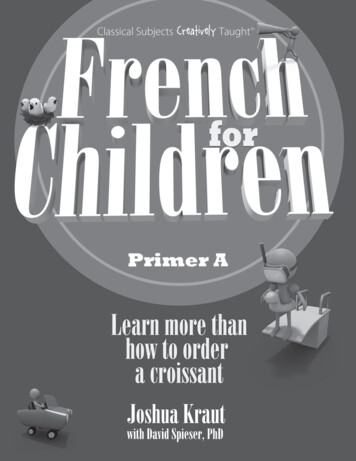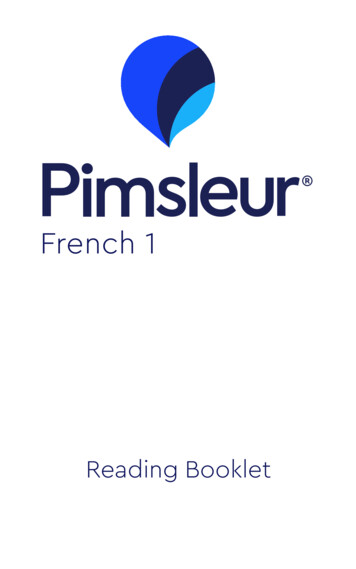
Transcription
French 1Reading Booklet
French 1Travelers should always check withtheir nation's State Department forcurrent advisories on local conditionsbefore traveling abroad.Booklet Design: Maia Kennedy and ‰ Recorded Program 2018 Simon & Schuster, Inc. Reading Booklet 2018 Simon & Schuster, Inc.Pimsleur is an imprint of Simon & Schuster Audio,a division of Simon & Schuster, Inc. Mfg. in USA.All rights reserved.ii
French 1ACKNOWLEDGMENTSVoicesEnglish-Speaking Instructor . . . . . . . . . . Ray BrownFrench-Speaking Instructor . . . Dominique ClémentFemale French Speaker . . Marie-P. Grandin-GilletteMale French Speaker . . . . . . . . . . . . . . . Pierre HurelWriterMarie-Pierre Grandin-GilletteEditorsElisabeth Weir Beverly D. HeinleReviewerKévin RocheronProducer & DirectorSarah H. McInnisRecording EngineerPeter S. TurpinSimon & Schuster Studios, Concord, MAiii
French 1Table of ContentsIntroduction . 1Reading . 5Leçon deux . 8Leçon trois . 10Leçon quatre .12Leçon cinq . 14Leçon six . 16Leçon sept . 18Leçon huit .20Leçon neuf . 22Leçon dix. 24Leçon onze . 25Leçon douze . 27Leçon treize . 29Leçon quatorze .31Leçon quinze . 33Leçon seize . 35Leçon dix-sept. 37Leçon dix-huit. 39Leçon dix-neuf . 41Leçon vingt . 43iv
French 1Leçon vingt-et-un . 45Leçon vingt-deux. 47Leçon vingt-trois . 49Leçon vingt-quatre . 51Leçon vingt-cinq .53Leçon vingt-six. 55Leçon vingt-sept . 57Leçon vingt-huit . 59Leçon vingt-neuf . 61Leçon trente . 63v
French 1IntroductionWelcome to the Third Edition of Pimsleur’sFrench Level 1.French, the sixth most-spoken language in theworld, is a Romance language, which means itcomes down from the common Latin of the RomanEmpire. Through France’s history of colonization,French has become an official language in 29Francophone countries spanning five continents,and there are numerous French-based creolelanguages, including Haitian Creole.French is a primary or secondary language ofnumerous international organizations includingNATO, the European Union, the United Nations, theWorld Trade Organization, and many more, as wellas having a distinguished history as an internationallanguage of scientific standards and literature.French has a deeply-ingrained relationship toEnglish dating from the Norman Conquest ofEngland, and many English words have a Frenchorigin, including those related to food, such asrestaurant, menu, café, salad, soup, beef, horsd’oeuvres, alcohol, and vinaigrette, as well as wordsconnected to fashion (such as chic, silhouette,petite, faux), travel (depot, en route, souvenir, Bonvoyage) and various aspects of life, such as critique,
French 1entrepreneur, genre, toilet, coup, and cliché.“RSVP” is short for Répondez S’il Vous Plaît, or,“Please respond.”As you will notice, if you have done previouseditions of this course, a few things have changedsince we last updated the course in 2009 to reflectFrance’s adoption of the euro as its currency.Languages are constantly evolving andreflecting changes in their societies. French is noexception. Just as first names like Georges orJacqueline are no longer first picks for Frenchbabies, the French you hear spoken in France todayis not the same French you heard twenty or moreyears ago, and certainly no longer the French youpreviously learned in school, even though thegrammar is still largely the same.For example, French people no longer refer tothe USA as l’Amérique, but instead say les Etats-Unis.Today, it is considered old-fashioned in France to callyoung women mademoiselle.Asking invertedquestions such as Parlez-vous anglais? orVoulez-vous danser? is also a thing of the past.Some outdated words and expressions havebeen dropped (ex. Zut and n’est-ce pas?); many2
French 1current ones have been added (excusez-moi, uneécharpe, un coca) and a few are still mentionedalong with a more modern alternate (comment? isnow less common than pardon? and on va muchmore frequent than nous allons).Also reflected in this new edition is a generaltrend in France toward casual interaction. Althoughspeaking politely and addressing people correctly isalways important, especially for beginning languagelearners, it is also useful to learn to interact morecasually while traveling, working, or vacationing inFrance. With this revised edition, you will be able toask questions both politely (Où est-ce que vousvoulez manger?) and casually (Vous voulez mangeroù?). You will also learn when and where to use thecasual tu (Tu vas bien, Juliette?) versus the formal“vous” (Vous allez bien, madame?) and you willbecome familiar with “on” (On est américains.)which is quickly overtaking “nous” (Nous sommesaméricains.) in everyday conversation.Similarly, the linking of words (liaison), a featureof pronunciation aimed at making French soundmore fluid, is less prevalent in conversation than itonce was. While some liaisons remain standard andmust be used (vous z-êtes, trois z-heures), othersthat were considered optional now tend to be3
FrenchFrench 1 1dropped altogether. For example, where once youmight have heard C’est t-ici (where the “t,” normallysilent in “est” is pronounced as if it were part of theword “ici), you will now more likely hear C’es(t) ici(where the “t” is silent, and there is no linkingbetween the two words). What was pro- nouncedpas z-allé is now pa(s) allé, etc. Again, the coursematerial addresses these changes and has beenrevised to reflect them.You will also notice that some phrases in thecourse are spoken first slowly, then a bit faster. Thisis done to help you clearly distinguish and recognizetheir components before you are asked to practicesaying them at a more natural conversational pace.With this newest edition of French 1, what youare learning is neither stilted “textbook” French, nor“street” French, but rather everyday French asspoken in France. Of course there are regionalaccents, so if you travel outside Paris to the seaside,or the countryside, or to the Alps, you might need toask people to repeat themselves or speak moreslowly. This is a common occurrence in anylanguage, and no one course can cover everypossible regional variation; however, the Frenchtaught in this course will be understood in every partof the country.4
French 1Remember, speaking French clearly and naturallyis not always easy to do at an introductory level, andyou may have to repeat a lesson a few times ifnecessary. The Pimsleur Method has a provensuccess rate and you will find that it is well worth theeffort. We hope you enjoy this latest third edition.ReadingReading is a critical part of learning and understanding a new language, but it may be for differentreasons than you think.If you’re like most people, you learned to speakyour native language well before you learnedto read it: you learned reading later—and it’s adifferent language skill, which uses a different partof your brain.The symbols you see on a page—the alphabet—are a sort of shorthand for the sounds they represent.Inside those sounds is where meaning actually lives.Not only is reading a piece of a language puzzle,learning to read also gives you a chance to learn alanguage from a different direction than how you arelearning to speak in the audio lessons. This “combi5
French 1nation approach” will help you build a solid bridgetoward fluency. You’ll be able to isolate sounds inthe spoken language that you couldn’t quite catchthrough listening alone, and you’ll begin to noticepatterns in words within the language that will helpyou create a web of understanding in your mind. Thisis the natural progression Dr. Pimsleur followed in allof his language courses.By the end of Lesson Two, you’ll have acquiredsome of the sounds of your new language and thereading lessons begin. Our approach is systematic.We’ll walk you through the sounds of the alphabetand you’ll learn how to pronounce letters that looklike English letters, but sound very different fromwhat you are used to, and, in some cases, letterswhich are totally new to you. You’ll also learn theimpact that a symbol, accent, or stress has onpronunciation. You won’t find a list of the words orsentences taught in the audio lessons, but insteadwe’ll take you to the source: sounds of individualletters and letter combinations, and you’ll learn howthese sounds play out in words and sentences. Don’tbe afraid to push yourself with your pronunciationand accent. Be dramatic and have fun! The closeryou can get to the native speaker’s pronunciation,the more authentic your experience will be, and thebetter you’ll remember.6
French 1Eventually, when you’ve mastered the soundsystem, you’ll be able to sound out words on sightand then read for meaning. By the end of the first 30lessons, you will be reading at the same level as youare speaking. You’ll find a Reading Lesson at the endof each of the rest of the audio lessons in this course,starting with Lesson Two.7
French 1Leçon bain16.feint17.lins18.ton19.ronds20.teint8
French 1Lesson Two1.no2.good3.bridge4.candy5.do (they)6.long7.long (plural)8.blonde nd (plural)20.dyed9
French 1Leçon ons8.bon vin9.bons vins10.dindon11.bain peint12.bons pains13.ton .mont10
French 1Lesson Three1.lead2.came3.are4.full5.twenty6.go (we)7.have (we)8.good wine9.good wines10.turkey11.painted bath12.good breads13.your .my20.mountain11
French 1Leçon e7.le monde8.le singe9.je songe10.la faim11.le bon vin12.la feinte13.je feins14.je vends15.le vent16.la vente17.le linge18.je mange19.je tends20.dedans12
French 1Lesson Four1.do (they)2.cast iron3.many a (masculine)4.many a (feminine)5.painted6.complaint7.the world8.the monkey9.I think10.the hunger11.the good wine12.the trick13.I pretend14.I sell15.the wind16.the sale17.the laundry18.I eat19.I hold out20.inside13
French 1Leçon cinq1.Je la vends.2.la bande3.Je le peins.4.Je la pends.5.le bon vent6.le bon temps7.Blanche8.Blanche chante.9.l’enfant10.L’enfant danse.11.le don12.la dent13.la danse14.madame15.sans dents16.son daim17.le drame18.la sainte19.les saintes20.ses ponts14
French 1Lesson Five1.I sell it.2.the gang3.I paint it.4.I hang it.5.the good wind6.the good times7.Blanche8.Blanche is singing / sings.9.the child10.The child is dancing / dances.11.the gift12.the tooth13.the dance14.madam15.without teeth16.his/her suede17.the drama18.the saint19.the saints20.his / her bridges15
French 1Leçon six1.des pentes2.mesdames3.mes chants4.méchant5.défense6.de France7.les dépenses8.Je comprends.9.vous parlez10.vous défendez11.vous répondez12.Vous ne parlez pas.13.des ponts14.Pas maintenant.15.élégant16.vous17.vous avez18.Vous avez des gants.19.vous n’avez pas20.Je ne comprends pas.16
French 1Lesson Six1.some slopes2.ladies3.my songs4.bad5.defense6.of France7.the expenses8.I understand.9.you speak10.you defend11.you answer12.You don’t speak.13.some bridges14.Not now.15.elegant16.you17.you have18.You have some gloves.19.you don’t have20.I don’t understand.17
French 1Leçon sept1.vous comprenez2.Vous me comprenez.3.Vous ne comprenez pas les enfants.4.Vous avez parlé?5.Non, pas beaucoup.6.Madame, je ne vous parle pas.7.Quelle bonté!8.Je dis que non.9.vous allez10.Tout dépend.11.Tout dépend de vous.12.Vous allez bien?13.Bonjour, monsieur.14.vous savez15.vous avez16.Vous n’avez pas de vin.17.Vous ne comprenez pas.18.Est-ce que vous comprenez?19.Vous comprenez tout.20.Ici on parle français.18
French 1Lesson Seven1.you understand2.You understand me.3.You don’t understand children.4.Did you speak?5.No, not a lot.6.Madam, I’m not speaking to you.7.What goodness!8.I say (that) no.9.you are going10.All depends.11.All depends on you.12.Are you well?13.Hello, sir.14.you know15.you have16.You don’t have any wine.17.You don’t understand.18.Do you understand
Welcome to the Third Edition of Pimsleur’s French Level 1. French, the sixth most-spoken language in the world, is a Romance language, which means it comes down from the common Latin of the Roman Empire. Through France’s history of colonization, French has become an official language in 29 Francophone countries spanning five continents, and there are numerous French-based creole

